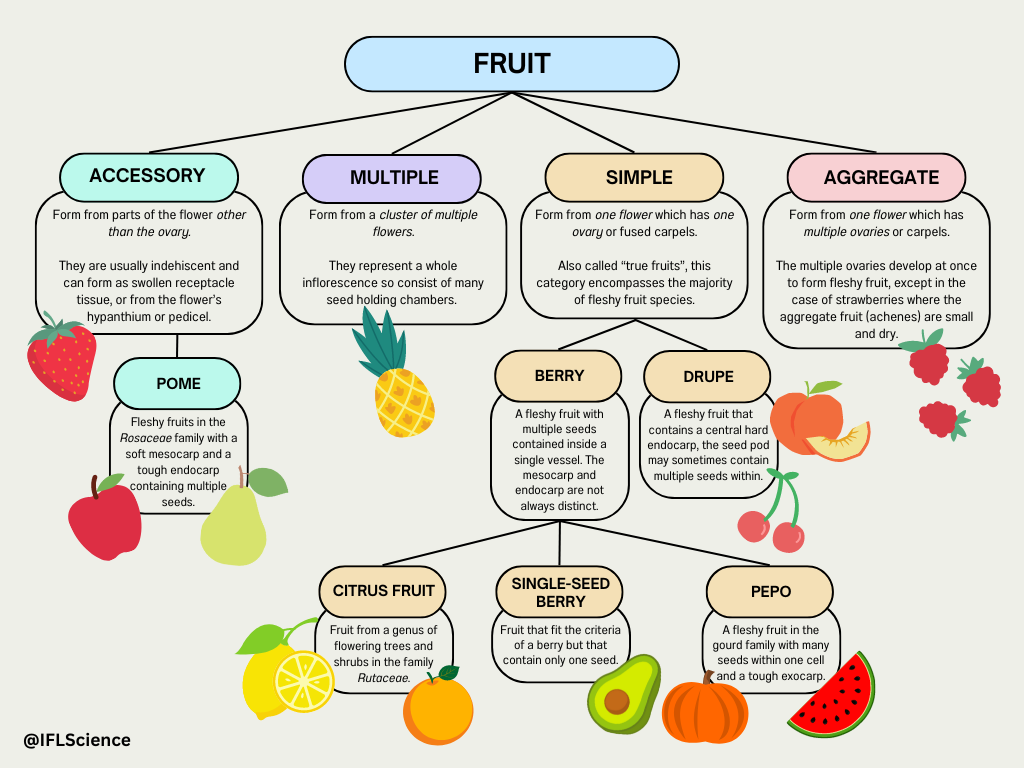Words like “fruit”, “berry”, and “vegetable” are thrown around with reckless abandon, taking little care for their botanic classifications. So, if you’d like help reducing your circle of friends, stick with us and we’ll teach you how to correctly identify all the taxonomic inaccuracies surrounding fruit and veg.
Let’s start off easy to whet your appetite for curiosity – tomatoes, cucumbers, and peppers aren’t actually vegetables, they’re all berries. But, raspberries and blackberries, they’re berries, right? WRONG! These imposters are all, in fact, aggregate fruits. Confused yet?
What makes something a fruit?
The term fruit is used to describe the fleshy ovary of a flowering plant that encloses a single or multiple seeds. The three main types of fleshy fruit are berries, pomes, and drupes, however, the fruit species that fall into these classifications may surprise you.
Fruits can be split into four distinct botanical classifications based on their origin:
- Aggregate fruits are derived from multiple ovaries, or carpels, within a single flower. The mature carpels fuse together to form the entire fruit. Raspberries are an example of an aggregate fruit, as are the achenes (the little dots that get mistaken for seeds) on a strawberry.
- Multiple fruits, or collective fruits, form from clusters of individual flowers that fuse together to make the fruit, as seen in pineapples.
- Accessory fruits, or false fruits, form from parts of the flower other than the ovary. The fleshy bit of strawberries, for example, is actually receptacle tissue, and the pome family, which includes apples and pears, form from the flower’s hypanthium.
- Simple fruits, or true fruits, are derived from one ovary in one flower. The drupe family, including peaches and plums, are all simple fruits, as are berries.
Within the simple fruit group are the subcategories of drupes and berries. Drupes are defined as fleshy fruit which contain a single seed – cherries, almonds, and mangos are drupes – but avocados are not. This is because the avocado stone, or endocarp, has a soft, thin skin surrounding it – to be a drupe, this central stone must be thick and hard.
What makes something a berry?
As simple fruit, berries are formed from the single ovary of a single flower. Berries are defined as fleshy fruits with multiple seeds contained inside a single vessel. Unlike drupes, the middle and inner layers (mesocarp and endocarp) are not distinct from each other.
Tomatoes and cucumbers are berries. Seeded banana and grape varieties are also berries, but some commonly consumed species reproduce through parthenocarpy meaning they don’t have seeds. Citrus fruits like limes and oranges are berries, as are pepos (melons and squashes), and avocados – which are single-seed berries.
By now you should have a pretty good grasp at identifying if something is an aggregate, multiple, accessory, or simple fruit, and if they would be considered a drupe or berry.
To test your knowledge, try to work out which categories these fruits belong in and why (answers at the end):

The four classifications of fruit.
Image credit: Canva.com edited by IFLScience
What makes something a vegetable?
While fruit grow from the flower of a plant, vegetables can be classified as practically any other piece of a plant that is edible. Plant roots, like radishes and carrots, are considered vegetables, as are the stems (asparagus and celery), leaves (cabbage and lettuce), seeds (peas and beans), bulbs (garlic and onion), or flowers before they develop into fruits (broccoli and cauliflower).
These botanical classifications, while distinct, have a lot of crossovers. Strawberries, and their achenes, for example, are both accessory and aggregate fruits. Plants like pumpkins can be both a fruit (the flesh) and a vegetable (the seed) depending on which part of it you consume.
Similarly, agricultural definitions define plants by how they are cultivated and consumed, while legal definitions can differ between countries and states. So, while it’s fun to be pedantic, don’t go starting any wars over the taxonomic classifications of fruit and veg.
QUIZ ANSWERS BELOW:
- Pomegranate – is a simple fruit as it comes from one ovary in one flower. As it contains multiple seeds, it is considered a berry.
- Fig – is both an accessory fruit, as the “fruit” is actually a cluster of inverted flowers, and a multiple fruit as it is formed from multiple flowers. These flowers also contain hundreds of achenes – an aggregate fruit – so technically, they’re all three!
- Kiwi – coming from one flower, kiwis are simple fruit and are considered berries as they contain multiple seeds.
- Blueberries – are actually berries! They are simple fruit as they come from a single flower with a single ovary and contain multiple seeds inside a fleshy casing.
- Olive – as they grow from a single flower, olives are simple fruits. Their hard-seeded centre also makes them part of the drupe classification.
Source Link: People Are Just Finding Out Raspberries Are Not Berries